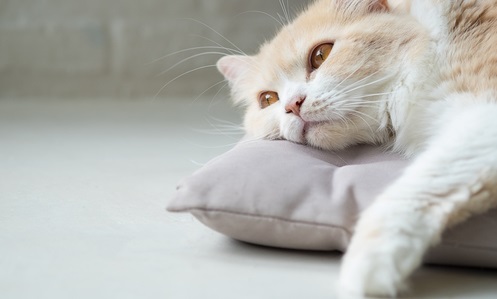Believe it or not, animals are subject to low blood sugar just like humans. In cats, low blood sugar is usually a symptom of a more serious ailment. Typically, there a chemical imbalance causes a cat to have low blood sugar. This condition of having low blood sugar is also called hypoglycemia and can be easily managed once the underlying cause is identified.
If a cat is exhibiting signs or symptoms of hypoglycemia, be sure to contact your vet immediately. Sometimes if a cat is having intense hypoglycemic symptoms, a vet may recommend giving the cat sugar in the form of honey or some other natural sugar. This quick hit of sugar will stabilize the cat’s condition and keep him alert and mobile enough to come in for an examination.
 If you are not directly ordered to take a specific action by your personal vet, do not take matters into your own hands. It is always best for the animal’s safety that you follow the explicit directions of veterinary professionals and allow them to direct the course of your cat’s treatment.
If you are not directly ordered to take a specific action by your personal vet, do not take matters into your own hands. It is always best for the animal’s safety that you follow the explicit directions of veterinary professionals and allow them to direct the course of your cat’s treatment.
What Is Hypoglycemia in Cats?
As previously stated, hypoglycemia is often a symptom of a greater underlying health issue. The most common reasons cats exhibit signs of hypoglycemia are feline liver disease, hyper or hypoactive thyroids, or feline diabetes. Usually, once hypoglycemia is identified as a symptom, a vet will run a panel of blood work and rigorous tests to determine the root cause of the hypoglycemia. Kittens are most susceptible to hypoglycemia as their bodily functions are not yet fully regulated. When introduced to outside stressors and bacteria, an already compromised internal system may fight back with symptoms of hypoglycemia.
Causes of Cat Hypoglycemia
In most cases, cats fall victim to low blood sugar due to increased levels of insulin in the blood. The increase of insulin in the blood starves the body of necessary sugars, which the brain needs to function correctly. Hypoglycemia does not directly affect muscle function, as muscles use proteins and fats to operate, even when sugar levels run low. However, muscle function, which is regulated by the brain, can fall victim to the plight of low blood sugar. As the brain begins to fail, the muscles in the body begin to spasm due to a lack of neurological signals being sent to the muscle tissue. Brain failure can lead to potential brain damage, so if a cat exhibits any signs of hypoglycemia, it is essential to take note and act quickly.
Hypoglycemia in Cats Symptoms
The following symptoms are the most common outward signs that a cat may be experiencing a hypoglycemic episode:
- Vomiting
- Diarrhea
- Seizures
- Muscles spasms
- Lethargy
- Lack of appetite
- Loss of muscle control
- Lack of depth perception
- Shaking/Shivering
- Dizziness and impaired motor functions
- Nervousness and increased skittishness
- Increased heart rate
- Heavy breathing
- Stumbling
- Coma
Treatment of Hypoglycemia in Cats
For the most part, hypoglycemia in cats is treatable and is most often tied to feline diabetes. While feline diabetes is serious, it is an illness that is not typically referred to as severe. With daily treatment and monitoring of insulin levels, cats with feline diabetes can lead very healthy lives. For feline diabetes, a vet will typically prescribe the cat doses of insulin to be taken regularly. It is crucial however that the owner of a cat with feline diabetes is vigilant about adhering to the proper dosage and administration of insulin, as too much or too little could cause the cat to become once again hypoglycemic.
 Some causes of hypoglycemia in cats are more severe than feline diabetes, and these causes include, but are not limited to, feline pancreatitis, liver disease, and sepsis. Pancreas-related issues have the highest probability of increased risk for hypoglycemia, as it is the pancreas, which produces and regulates insulin in the body. If a cat has an issue that is caused by complications with the pancreas, it is more likely that hypoglycemic episodes will be a recurring problem.
Some causes of hypoglycemia in cats are more severe than feline diabetes, and these causes include, but are not limited to, feline pancreatitis, liver disease, and sepsis. Pancreas-related issues have the highest probability of increased risk for hypoglycemia, as it is the pancreas, which produces and regulates insulin in the body. If a cat has an issue that is caused by complications with the pancreas, it is more likely that hypoglycemic episodes will be a recurring problem.
Wrapping Up
Sometimes hypoglycemia is the result of something as simple as too much exercise, or not eating enough. In some rare cases, cats have been known to exhibit signs of hypoglycemia when they go into diabetic remission. As cats go into diabetic remission, their body can produce its own insulin at the correct levels. However, if prescribed insulin are still being administered before remission is detected, then the cat could exhibit symptoms of hypoglycemia due to too much insulin in the blood. Whatever the deeper cause of feline hypoglycemia, when symptoms become apparent, it is necessary to take immediate action. Work with a vet to find a short-term remedy and a long-term treatment plan.
Sources:
- “Hypoglycemia in Cats.” Pet Health Network, www.pethealthnetwork.com/cat-health/cat-diseases-conditions-a-z/hypoglycemia-cats.
- “Low Blood Sugar in Cats.” PetMD, www.petmd.com/cat/conditions/endocrine/c_ct_low_blood_sugar.
- “Hypoglycemia in Cats – Symptoms, Causes, Diagnosis, Treatment, Recovery, Management, Cost.” WagWalking, 19 Nov. 2016, wagwalking.com/cat/condition/hypoglycemia.




